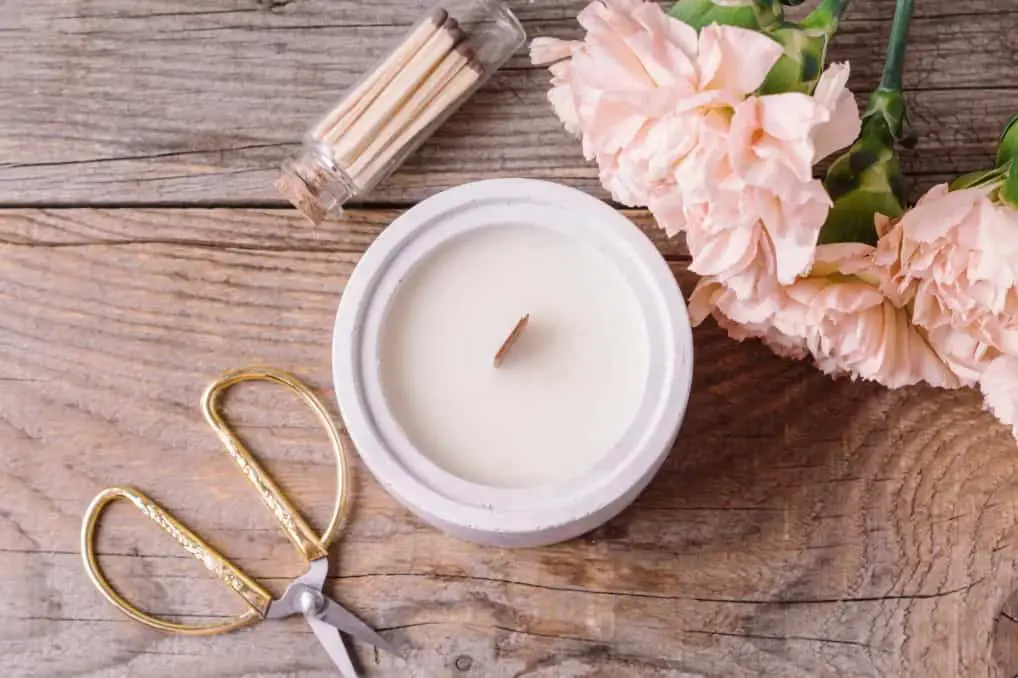If you’ve been with me through this candle-making journey, then you know how satisfying the end results can be! And if there is one thing wood wick candles are all about (besides their crackling sound), its beauty. This definitive guide will make sure your next batch of wood wick candles comes out looking like they've reached perfection before even lighting them up. I know you're all excited to get started with the woodwick candle making, but before we do, there are a few things that need clarification. Now I'm not going in with any preconceived notions so let me lay everything out for you all!

And, if this is your first time making candles (or even just curious about how it all works), I recommend you start with our step-by-step guide to make DIY scented candles. That being said, here are some of the most common wood wick myths that you need to know.
Woodwick candle making myths!
It turns out there isn't one single truth behind which type or kind of material should be used in woodwick candle making; instead, every manufacturer has their own preference based on what they believe gives off better quality end product while also being cost-effective enough where everyone can enjoy them without breaking the bank!
At the point when you go for a web search about ''Wooden Wick'', that is certainly not a new thing in candle making, but rather clearly, it’s more uncommon than the cotton wick. You will find loads of misdirecting and confounding myths about wooden candle wick.
Common wood wick myths
Following are the most generally held confusions about wooden wicks regarding the assembling system and execution of finished items:
Myth no 1: You have to soak wooden wicks in oil or a burning agent before using them.
No, you don't. You can utilize them similarly as they are, raw and untreated.
Myth no 2: The longer the wood wick, the bigger is flame.
No, appropriate stature and size of the wick are needed as per the vessel and wax combination for an ideal flame.
Myth no 3: Wooden wicks are harder to use than cotton.
No, wooden wicks are really simpler to make, however, with a right wick. Moreover, wood wick saves time in candle making as it doesn't need a wick centering instrument.
Myth no 4: Wooden wick candles do not burn for long hours like cotton wicks?
Myth no 5: Wooden wicks are not appropriate for soy wax.
Yes, they are. To make a wooden wick ideal for soy wax, appropriately estimated wick both in thickness and width required.
Myth no 6: Woodwicks are not appropriate for high fragrance scented candles?
Everything's tied in with utilizing the right wick size for the candle container measurement, wax mix, and fragrance load.
Myth no 7: I can make a woodwick at home from any sort of wood?
No, you shouldn’t use any type of wood. Use of suitable wood as recommended by authorized wick and candle maker ensures safe burning of wood wicks with no undesirable by-product.
Weird wood wick myths
Some myths just don’t make any sense!
Myth no 8: Wooden wick candle contributes to climate change?
No, you are even supporting well-managed forest production by purchasing wooden wick candles from reputed vendors.
Myth no 9:Woodwicks do not crackle?
Wooden wicks crackle with the proper wick size for candle size and wax blend.
Now that the fog is clear let's see how the wooden wick candle produces the crackling sound.
What makes the crackling woodwick?
The crackle of the burning wood wick candle gives you the perfect campfire vibes. 96% of the candle addicts find burning a crackling wood wick candle more relaxing than a cotton wick candle. But what exactly makes the wooden wick candles such favorites? We can find the answer by looking at where things started:
- Woodwick is a natural wood meaning it has the same cellular constitution. It’s a plant with cells, molecules, and gases. Now the cell wall is elastic, but only to a limit. Raising the temperature expands the gas trapped inside the cells. In other words-explodes, resulting in burst open cells releasing gas trapped within them. This produces the crackling, popping sounds we hear from burning a wooden wick.
- Moisture content also plays a key role in determining the amount of crackle you will hear from wood wick candles. Softwood wicks have water pockets in them that get heated and pressurized to produce steam which eventually burst to give off a crackling sound.
Which wood wick should you use for woodwick candle making?
Wick choice is so exceptionally important as wicks provide the changing measures of fuel(wax) to the fire depending upon its size by absorbing melted wax. Wick size relies on the absolute detailing of flame; wax, fragrance, dye, and added substances. Wicks are usually made from the wood of balsa, birch, cherry, maple, oak, rosewood, or their combination.
Wood wicks can be categorized as Single-ply wick(flat wick), Booster wick, and Spiral wick used with appropriate wax types.
1- Spiral or single plywood wicks
Spiral or single plywood wicks are usually 0.02″ to 0.04″ thick and 0.375″ to 0.75″ wide. These wooden wicks are best suited for paraffin or other non-natural/synthetic wax types.
2- Booster wicks
Booster wicks are similar to single-ply wicks, except they have an additional wooden strip. These wicks will give an extra oomph to your scented natural wax candles such as soy candles, beeswax candles, or apricot-coconut blend.
3- Spiral wooden wicks
These coreless, spiral wooden wicks aren't very popular with candle makers.
View this table to get the recommended wick type and size for your wax and container size.
Here’s how to make your own wicks for wood wick candle making
Easy to make, simple to light, normal burning quality, adaptability with various wax types, the popping open-air sparkle they transmit when lit are qualities of wooden wicks. Making your wood wick for candles is cost-effective to the point that you can spend your cash on different supplies more.
All you need is a balsa wood stick, scissors, olive oil, and wood wick tabs to get started with making your own crackling wooden wicks.
Balsa wood sticks are the simplest and most reasonable type of wooden wicks. They are effectively accessible long, lightweight sticks. However, you can also use other types of wood sticks for making wicks.

Follow the steps to make balsa wood sticks into wood wicks.
- Utilize ordinary scissors, cut balsa wood to your necessary size with scissors. It should cut the wood to be around 1 inch longer than the length of your container.
- Soak the sticks in olive oil or coconut oil in a shallow dish such that all sides of the sticks are covered in oil.
- Allow the sticks to soak for about 30 minutes. Then, remove all sticks and wipe them with a paper towel.
- Now take wick tabs that are specifically designed for wood wicks and push the oil-treated wood pieces into those tabs.
- Allow these handcrafted crackling wood wick candles to dry for at least three days before burning for an extraordinary fragrance throw.
Let’s now dive into woodwick candle making with coffee beans and soy wax
What would you say to a recipe that smells of freshly brewed coffee, with the added bonus of crackling wood? If your answer is "yes," then we have just what you're looking for. This signature-smelling candle will transport you to your favorite café and keep the scent lingering in every room of your house long after the candle has burned itself out!
Supplies needed for woodwick candle making:
- Soy wax
- Woodwick with tab and wick clip
- ½ ounce coffee oil
- One teaspoon cooked coffee beans
- Woodwick candle-making accessories include a non-stick pouring pot, spatula or spoon, thermometer, paper towels, etc.
Step by step guide to woodwick candle making
- Take a heat-safe or pouring po and measure your wax into it. The quantity of wax depends on the size of the container you are choosing. The size of the container ought to be between 3'' – 4'' tall and 2.5'' – 3'' in diameter.
- Heat the wax using the double boiler technique by suspending the container holding the wax over a pot of stewing water. Mix the wax with a non-stick spoon until it's totally softened to clear fluid. Try not to contact the hot glass.
- Add a couple of drops of your favorite coffee fragrance oil and add a teaspoon of cooked coffee beans to color the wax to make a scented candle.
- To prevent jump lines in the finished candle, warm the glass jar right before pouring liquid wax into it. Submerge candle containers in a sink or bowl of heated water and remove them with tongs when prepared to pour melted wax. Dry their inner parts completely.

- To prevent the candle's flame excessively near the edge of the container, keep the wick tab centered when the melted wax is poured. This can be done by pressing a wick tab onto the bottom center of a glass jar using a wick sticker or wax dots.
- Slowly pour the hot liquid wax into the jar, coating the wooden wick and filling the jar to no higher than 1 inch below the base of the rim. Allow the wax to completely cool and harden.
- Remember to wear a heat-safe hot pad, oven mitt, or glove before pouring.
- At the point when the candle is cool, trim the wooden wick to 1/4 inches over the wax using a wick trimmer, and they're ready for use.
Woodwick candle making: cold throw Vs hot throw
While picking a fragrance for your scented candle, remember that you select essential oil that is explicitly known for candle making and smells lovely. The proposed fragrance load of essential oil is anyplace between 8-12% of your general mix. This will assist with guaranteeing a solid cold and hot throw while keeping up with flame brightness.
The cold throw is the measure of scent that is produced when it isn't burning, while the hot throw is the measure of fragrance that is discharged when it is burning. On the off chance that you've at any point bought a candle that smells incredible from the beginning yet didn't do much once it began burning, you will complain of your hot throw.
Wooden wicks are known for their magnificent capacity to diffuse essential oil and deal with an amazing hot throw. If you are having issues with your hot throw of soy candle, or the absence of one, we recommend evaluating your wooden wicks or expanding your fragrance load up to 12%.
Woodwick candles burn clean and safe
Whichever candle you burn or make at home, smoke-free flame and safe candle burning features are always crucial for the safety of your family and your home. Wood wicks are 100 percent naturally-sourced, eco-friendly, non-toxic, and safe to burn.
Wooden wick candles offer an escape from those metal-cored wicks or cotton wicks that are soaked in paraffin wax. These that can be toxic for your family as well as harmful to their health over time. They're made with natural materials which burn cleaner than most other store-bought wicks today.
The basic rules of wood wick candle safety include, just as all candles, keeping children, pets, drapes, and curtains away from an open flame; burning candles on flat surfaces; and never lit a candle with less than half-inch of wax left.
Is wood wick good for soy wax candle?
Soy wax is the ideal candle wax for woodwick, even suggested by providers. Choose the wax that will work best as a container soy candle. You might experience sinkholes or tunneling, wet spots, and frosting even with 100% pure soy wax. Don’t sweat about these issues. These issues can be avoided by applying the following tricks:
- Clean your candle jar with warm water and dry it thoroughly before pouring melted wax into it.
- Preheat your jar in a warm broiler (100-110 degrees F) to slow the cooling of the container candles.
- Pour your candle wax at a hotter room temperature (70-75 degrees F).
6-8 percent of fragrance load is recommended for making the best crackle measure, and soy wax can deal with a higher scent load even if you do not get as much crackle beyond 8 percent.
How to get the most out of your wood wick with soy candles?
Wood wick soy candles are a little different from a traditional cotton wick soy candle. They burn longer than cotton wicks and produce a soothing crackling sound. A good, crackling candle that smells great and gives off just enough heat without being overwhelming will make any space come alive! However, if your candle isn't staying lit or producing crackles, there's something wrong with it.
Here are a few things you can do to fix the issues to get the best results for your wood wick soy candles!
Candles have a wax memory
Lighting a wood wick is just like lighting a fire in the hearth. It takes time to get a wood wick flaming. However, once lit, allow it to burn for enough time to create a wax pool that goes all the way to the edges of the container.
This is because the first burn is important in candles. It creates a memory or a pattern of burning. If you don't allow your candle to burn appropriately for the first time, it will result in tunneling around the wick that will continue to the bottom of the jar. Such candles have trouble staying lit for a longer time.

The shorter the wood wick, the longer it stays lit
The wax fuels the flame, and wick play an essential role in pulling it up. A short wick allows the wax melt to make it to the flame faster than the longer wick and keeps it lit.
Therefore, use a wick trimmer to keep your wick trimmed to about 1/4 or 1/8 inches above the wax.
Reset candle memory to cure tunneling
The best candle-burning practice is to have your wick trimmed to ¼ inches every time before burning and your wax pool to the edges of the glass jar. However, if your candle has started to form tunnels for any unknown reason, burn it for a maximum of 4 hours till there is a wide wax melt to the ends of the container. Viola! Your candle's wax memory has been reset.
If it is still drowning around the wick, try scrapping the hard wax around the wick to melt it.
In short, light your candles with patience, allow them to produce a melt pool, and trim your wicks regularly to avoid any problems with woodwick candles.
Do you have any favorite woodwick candle making recipes? We'd love to try it as well – leave it in the comments here.






